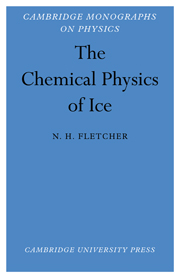Book contents
- Frontmatter
- Contents
- Preface
- Note on Units
- CHAPTER 1 The water molecule
- CHAPTER 2 Structure and energy of ordinary ice
- CHAPTER 3 Other forms of ice
- CHAPTER 4 Liquid water and freezing
- CHAPTER 5 Crystal growth
- CHAPTER 6 Thermal properties and lattice dynamics
- CHAPTER 7 Point defects
- CHAPTER 8 Mechanical properties
- CHAPTER 9 Electrical properties
- References
- Subject Index
CHAPTER 2 - Structure and energy of ordinary ice
Published online by Cambridge University Press: 21 May 2010
- Frontmatter
- Contents
- Preface
- Note on Units
- CHAPTER 1 The water molecule
- CHAPTER 2 Structure and energy of ordinary ice
- CHAPTER 3 Other forms of ice
- CHAPTER 4 Liquid water and freezing
- CHAPTER 5 Crystal growth
- CHAPTER 6 Thermal properties and lattice dynamics
- CHAPTER 7 Point defects
- CHAPTER 8 Mechanical properties
- CHAPTER 9 Electrical properties
- References
- Subject Index
Summary
Following on our survey of the properties of the water molecule, we now come to consider the ways in which these molecules link together to form a liquid or a solid phase. This is a large subject and we shall treat it in several stages. In the present chapter we look at ordinary ice—Ice Ih—and see what is known about its crystal structure and cohesive energy. With this discussion as a background, we shall then go on to consider the other forms of ice which can exist at low temperatures or at high pressures and to take an over–all view of the phase diagram of the material called water.
Crystal structure of Ice Ih
The equilibrium structure to which a material crystallizes under given conditions of temperature and pressure is completely determined by the interaction forces between its molecules and these, in turn, are determined by the electronic structure of those molecules, as we have seen. Unfortunately it is almost impossible to proceed uniquely in this way from molecules to crystals in any but the very simplest solids, because the interaction forces are not known with sufficient accuracy. We must therefore usually content ourselves with observing that the crystal structure which actually occurs is consistent with what is known of the molecular interactions, and with comparing the value which we can calculate for its cohesive energy with that found from experiment.
- Type
- Chapter
- Information
- The Chemical Physics of Ice , pp. 23 - 48Publisher: Cambridge University PressPrint publication year: 1970
- 4
- Cited by



